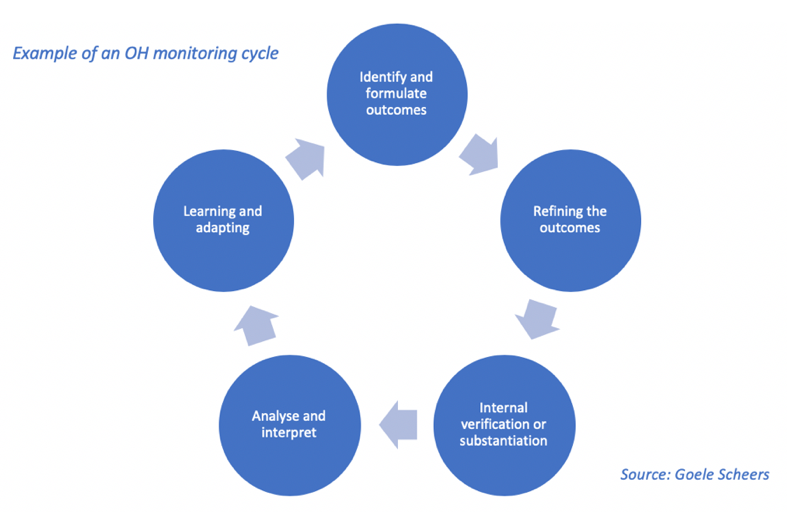Tuesday, March 26, 2019
Hi, I am
Goele Scheers, an independent M&E consultant based in Belgium. I have worked closely with Ricardo Wilson-Grau since Outcome Harvesting (OH) was being developed and was working on an OH evaluation with him throughout his final year of life. I have always used OH for both monitoring and evaluation.
Outcome Harvesting works well for monitoring because staff engaged in implementing and monitoring the program can easily grasp “outcomes” as defined by OH, and take part in data collection, analysis and use of findings. OH can be combined with other methods to strengthen a monitoring system.
In a few ways, the use of Outcome Harvesting for monitoring is different than for evaluation. In an ongoing monitoring process, the steps occur in a cycle and don’t end with the use of findings. Instead of an external consultant who coaches the sources in formulating their outcomes, an organization will need to carefully consider who will harvest outcomes from who and on which level of the organization, network or partnership the ‘pingponging’ or refining of the outcomes will take place. Different methods for harvesting the outcomes (e.g., workshops, virtually) can be used within a single organization or program, depending on the use and the context. Most of my clients have found that identifying outcomes from documentation is less useful for monitoring, as the outcomes are being captured by the informants when they occur, that means on a continuous or at least frequent basis. Substantiation may not be included in every harvest cycle or it may even be left for evaluation. In some cases, I include a step on cross-organizational verification (very useful in networks or partnerships) or internal verification (checking the outcomes between different programs). In an ongoing monitoring process, the organization will need to decide at which point to analyze and interpret the harvested outcomes. For example, it may be that the informants upload their outcomes into a database at any point in time, but the analysis and interpretation only take place twice a year. Contrary to an external evaluation, the sources can be involved in the interpretation.
 Lessons Learned:
Lessons Learned: When using OH for monitoring, it can be challenging to keep the enthusiasm from the first harvesting round in subsequent rounds. Use of the harvest findings is the best motivator! Program staff are most likely to remain actively engaged in harvesting outcomes when they are able to use the findings to strengthen the program and its results.
Hot Tips:- Incorporate the harvesting and sensemaking moments into existing spaces in the organization so it is not experienced as something additional that needs to be done.
- Organizations that use OH on an ongoing basis, will sooner or later need a database to store all the outcomes. Look into the tools the organization is using already to see if they can be adapted for OH. I’ve found Podio a very useful tool for harvesting, refining and storing the outcomes.
The American Evaluation Association is celebrating Outcome Harvesting week. The contributions all this week to aea365 come from colleagues of the late Ricardo Wilson-Grau, originator of Outcome Harvesting, and these articles are written in his honor. Do you have questions, concerns, kudos, or content to extend this aea365 contribution? Please add them in the comments section for this post on the aea365 webpage so that we may enrich our community of practice. Would you like to submit an aea365 Tip? Please send a note of interest to aea365@eval.org. aea365 is sponsored by the American Evaluation Association and provides a Tip-a-Day by and for evaluators. 
About AEA
The American Evaluation Association is an international professional association and the largest in its field. Evaluation involves assessing the strengths and weaknesses of programs, policies, personnel, products and organizations to improve their effectiveness. AEA’s mission is to improve evaluation practices and methods worldwide, to increase evaluation use, promote evaluation as a profession and support the contribution of evaluation to the generation of theory and knowledge about effective human action. For more information about AEA, visit www.eval.org.